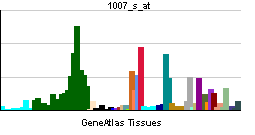DDR1
For the older type of computer memory, see DDR SDRAM.
| Discoidin domain receptor family, member 1 | |||||||||||
|---|---|---|---|---|---|---|---|---|---|---|---|
| Identifiers | |||||||||||
| Symbols | DDR1 ; CAK; CD167; DDR; EDDR1; MCK10; NEP; NTRK4; PTK3; PTK3A; RTK6; TRKE | ||||||||||
| External IDs | Template:OMIM5 Template:MGI HomoloGene: 68212 | ||||||||||
| |||||||||||
| RNA expression pattern | |||||||||||
 | |||||||||||
 | |||||||||||
 | |||||||||||
| More reference expression data | |||||||||||
| Orthologs | |||||||||||
| Template:GNF Ortholog box | |||||||||||
| Species | Human | Mouse | |||||||||
| Entrez | n/a | n/a | |||||||||
| Ensembl | n/a | n/a | |||||||||
| UniProt | n/a | n/a | |||||||||
| RefSeq (mRNA) | n/a | n/a | |||||||||
| RefSeq (protein) | n/a | n/a | |||||||||
| Location (UCSC) | n/a | n/a | |||||||||
| PubMed search | n/a | n/a | |||||||||
Discoidin domain receptor family, member 1, also known as DDR1 or CD167a (cluster of differentiation 167a), is a human gene.[1]
Receptor tyrosine kinases (RTKs) play a key role in the communication of cells with their microenvironment. These molecules are involved in the regulation of cell growth, differentiation and metabolism. The protein encoded by this gene is a RTK that is widely expressed in normal and transformed epithelial cells and is activated by various types of collagen. This protein belongs to a subfamily of tyrosine kinase receptors with a homology region to the Dictyostelium discoideum protein discoidin I in their extracellular domain. Its autophosphorylation is achieved by all collagens so far tested (type I to type VI). In situ studies and Northern-blot analysis showed that expression of this encoded protein is restricted to epithelial cells, particularly in the kidney, lung, gastrointestinal tract, and brain. In addition, this protein is significantly over-expressed in several human tumors from breast, ovarian, esophageal, and pediatric brain. This gene is located on chromosome 6p21.3 in proximity to several HLA class I genes. Alternative splicing of this gene results in multiple transcript variants.[1]
References
Further reading
- Edelhoff S, Sweetser DA, Disteche CM (1995). "Mapping of the NEP receptor tyrosine kinase gene to human chromosome 6p21.3 and mouse chromosome 17C". Genomics. 25 (1): 309–11. PMID 7774938.
- Shelling AN, Butler R, Jones T; et al. (1995). "Localization of an epithelial-specific receptor kinase (EDDR1) to chromosome 6q16". Genomics. 25 (2): 584–7. PMID 7789998.
- Weiner TM, Liu ET, Craven RJ, Cance WG (1995). "Expression of growth factor receptors, the focal adhesion kinase, and other tyrosine kinases in human soft tissue tumors". Ann. Surg. Oncol. 1 (1): 18–27. PMID 7834423.
- Laval S, Butler R, Shelling AN; et al. (1995). "Isolation and characterization of an epithelial-specific receptor tyrosine kinase from an ovarian cancer cell line". Cell Growth Differ. 5 (11): 1173–83. PMID 7848919.
- Kato JY, Matsuoka M, Strom DK, Sherr CJ (1994). "Regulation of cyclin D-dependent kinase 4 (cdk4) by cdk4-activating kinase". Mol. Cell. Biol. 14 (4): 2713–21. PMID 8139570.
- Di Marco E, Cutuli N, Guerra L; et al. (1993). "Molecular cloning of trkE, a novel trk-related putative tyrosine kinase receptor isolated from normal human keratinocytes and widely expressed by normal human tissues". J. Biol. Chem. 268 (32): 24290–5. PMID 8226977.
- Perez JL, Shen X, Finkernagel S; et al. (1994). "Identification and chromosomal mapping of a receptor tyrosine kinase with a putative phospholipid binding sequence in its ectodomain". Oncogene. 9 (1): 211–9. PMID 8302582.
- Johnson JD, Edman JC, Rutter WJ (1993). "A receptor tyrosine kinase found in breast carcinoma cells has an extracellular discoidin I-like domain". Proc. Natl. Acad. Sci. U.S.A. 90 (12): 5677–81. PMID 8390675.
- Perez JL, Jing SQ, Wong TW (1996). "Identification of two isoforms of the Cak receptor kinase that are coexpressed in breast tumor cell lines". Oncogene. 12 (7): 1469–77. PMID 8622863.
- Valent A, Meddeb M, Danglot G; et al. (1996). "Assignment of the NTRK4 (trkE) gene to chromosome 6p21". Hum. Genet. 98 (1): 12–5. PMID 8682498.
- Playford MP, Butler RJ, Wang XC; et al. (1996). "The genomic structure of discoidin receptor tyrosine kinase". Genome Res. 6 (7): 620–7. PMID 8796349.
- Sakuma S, Saya H, Tada M; et al. (1997). "Receptor protein tyrosine kinase DDR is up-regulated by p53 protein". FEBS Lett. 398 (2–3): 165–9. PMID 8977099.
- Nemoto T, Ohashi K, Akashi T; et al. (1998). "Overexpression of protein tyrosine kinases in human esophageal cancer". Pathobiology. 65 (4): 195–203. PMID 9396043.
- Tanaka K, Nagayama Y, Nakano T; et al. (1998). "Expression profile of receptor-type protein tyrosine kinase genes in the human thyroid". Endocrinology. 139 (3): 852–8. PMID 9492013.
- Vogel W, Gish GD, Alves F, Pawson T (1998). "The discoidin domain receptor tyrosine kinases are activated by collagen". Mol. Cell. 1 (1): 13–23. PMID 9659899.
- Shrivastava A, Radziejewski C, Campbell E; et al. (1998). "An orphan receptor tyrosine kinase family whose members serve as nonintegrin collagen receptors". Mol. Cell. 1 (1): 25–34. PMID 9659900.
- Vogel W, Brakebusch C, Fässler R; et al. (2000). "Discoidin domain receptor 1 is activated independently of beta(1) integrin". J. Biol. Chem. 275 (8): 5779–84. PMID 10681566.
- Foehr ED, Tatavos A, Tanabe E; et al. (2000). "Discoidin domain receptor 1 (DDR1) signaling in PC12 cells: activation of juxtamembrane domains in PDGFR/DDR/TrkA chimeric receptors". FASEB J. 14 (7): 973–81. PMID 10783152.
- Weiner HL, Huang H, Zagzag D; et al. (2001). "Consistent and selective expression of the discoidin domain receptor-1 tyrosine kinase in human brain tumors". Neurosurgery. 47 (6): 1400–9. PMID 11126911.
- Mohan RR, Mohan RR, Wilson SE (2001). "Discoidin domain receptor (DDR) 1 and 2: collagen-activated tyrosine kinase receptors in the cornea". Exp. Eye Res. 72 (1): 87–92. doi:10.1006/exer.2000.0932. PMID 11133186.
| Stub icon | This membrane protein–related article is a stub. You can help Wikipedia by expanding it. |
This article incorporates text from the United States National Library of Medicine, which is in the public domain.